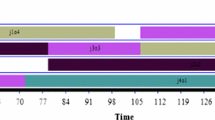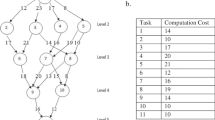Abstract
This paper proposes a molecular algorithm for a job shop problem based on intermediate time consumed between operations of jobs. This problem is an NP-complete problem in a silicon-based computation environment. Thus, using any parallel algorithm for solving this problem can be useful. In this paper, enormous parallelism power of molecular computation is used. In addition, intermediate consumed time between operations is considered. Our solution consists of specifying one direction of conjunctive edges between each pair of operations using both mask and coloring techniques. Based on the resulted directions in a graph, all the valid schedules are found and, finally, the best one is selected according to the consumed time of all operations. The proposed molecular algorithm performs in the complexity of O(max (n,m)). The effectiveness of this algorithm is verified by a computational simulation.

Similar content being viewed by others
Reference
Bulbul K., Kaminsky P., Yano C: Flow shop scheduling with earliness, tardiness and intermediate inventory holding costs. Naval Res. Logist. 51(3), 407–445 (2004)
Amos, M.: DNA computation. Ph.D. Thesis, Department of Computer Science, University of Warwick, UK (1997)
Hsieh S.-Y., Huange C.-W., Chou H.-H: A DNA-based graph encoding scheme with its application to graph isomorphism problems. Appl. Math. Comput. 203, 502–512 (2008)
Adleman L.M: Molecular computation of solutions to combinatorial problems. Science 266, 1021–1029 (1994)
Lipton R: DNA solution of hard computational problem. Science 268, 542–545 (1995)
Lee J.Y., Shin S.Y., Park T.H., Ghang B.T: Solving traveling salesman problems with DNA molecules encoding numerical values. BioSystems 78, 39–47 (2004)
Darehmiraki M., Nehi H.M: Molecular solution to the 0–1 knapsack problem based on DNA computing. Appl. Math. Comput. 187, 1033–1037 (2007)
Henkel C.V., Back T., Kok J.N., Rozenberg G., Spaink H.P: DNA computing of solutions to knapsack problems. Biosystem 88, 156–162 (2007)
Moreno A.G: Solving traveling salesman problem in simulation of Genetic algorithm with DNA. Int. J. Inf. Theories Appl. 15, 357–363 (2008)
Sanches C.A.A., Soma N.Y: A polynomial time DNA computing solution for the bin-paking problem. Appl. Math. Comput. 215, 2055–2062 (2009)
Sharif Ullah, A.M.M.: A DNA-based computing method for solving control chart pattern recognition problems. CIRP J. Manuf. Sci. Technol. (2011)
Rothemund, P.: A DNA and restriction enzyme implementation of Turing machines. In: Landweber, L.; Baum, E. (eds.) DNA Based Computers, vol. 27. American Mathematical Society, Providence, pp. 75–119 (1996)
Paun G., Rozenberg G., Salomaa A: DNA Computing: New Computing Paradigm. Springer, Berlin (1998)
Amos, M.; Dunne, P.: DNA Solution of Boolean Circuit, Tech. Rep. CTAG-97009. Department of Computer Science, University of Liverpool (1995)
Ogihara, M.; Ray, A.: Simulating Boolean circuit on DNA computers, Algorithmica 2–3, 239–250 (1999)
Wang, L.; Liu, Q.; Frutos, A.; Gillmor, S.; Thiel, A.; Strother, T.; Condon, A.; Corn, R.; Lagally, M.; Smith, L.: Surface-based DNA computing operations: destroy and readout. Biosystems 52(1) (1999)
Winfree, E.: Algorithmic Self-Assembly of DNA, thesis in P.H.D degree, California Institute of Technology, Pasadena (1998)
Qiu Z.F., Lu M: A new approach to advance the DNA computing. Appl. Soft Comput. 3, 177–189 (2003)
Chena X., Wanga N: Optimization of short-time gasoline blending scheduling problemwith a DNA based hybrid genetic algorithm. Chem. Eng. Process. 49, 1076–1083 (2010)
Zhixiang Y., Jianzhong C., Yan Y., Ying M: Job shop scheduling problem based on DNA computing. J. Syst. Eng. Electron. 17(3), 654–659 (2006)
Ahrabian H., Ganjtabesh M., Nowzari-Dalini A: Molecular solution for double and partial digest problems in polynomial time. Comput. Inf. 28, 1001–1020 (2009)
Ahrabian, H.; Ganjtabesh, M.; Nowzari-Dalini, A.: A Molecular Algorithm for Longest Path Problem
Smithies O: Zone electrophoresis in starch gels: group variations in the serum proteins of normal adults. Biochem. J. 61(4), 629–641 (1955)
Schägger H: Tricine-SDS-PAGE. Nat. Protoc. 1(1), 16–22 (2006)
Beck, J.C.; Prosser, P.; Selensky, E.: Graph transformationsnfor the vehicle routing and job shop scheduling problems. Lecture Notes in Computer Science, vol. 2502, pp. 60–74 (2002)
Author information
Authors and Affiliations
Corresponding author
Rights and permissions
About this article
Cite this article
Molaei, S., Vahdani, B. & Molaei, S. A Molecular Algorithm for an Operation-based Job Shop Scheduling Problem. Arab J Sci Eng 38, 2993–3003 (2013). https://doi.org/10.1007/s13369-012-0458-0
Received:
Accepted:
Published:
Issue Date:
DOI: https://doi.org/10.1007/s13369-012-0458-0




